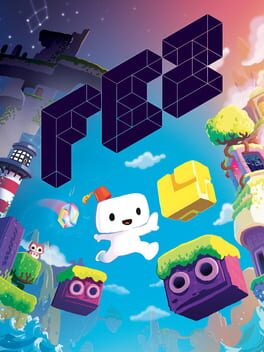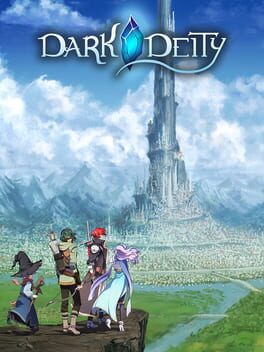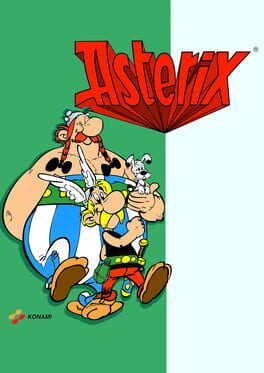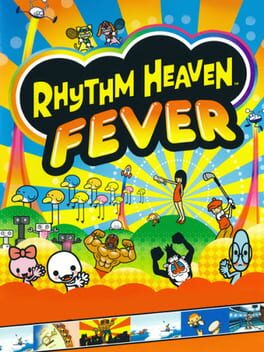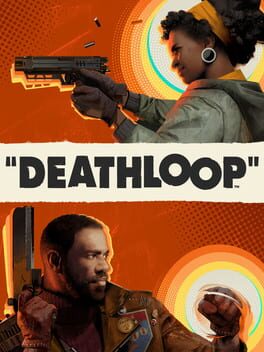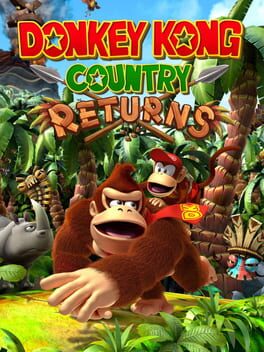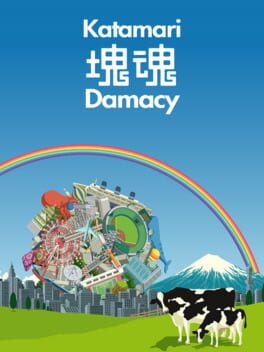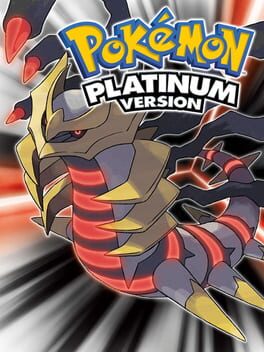6 reviews liked by D484
Fez
2012
Content Warning: This essay deals with topics such as death, panic attacks, existentialism, the abstract and the unknown, a rather atheistic world view, and topics which float around them. It is also, coincidentally, a giant rabbit hole. These relate to my own personal experiences and are told primarily from my perspective above all else. The majority of the review will not touch upon these topics, but I will signal again later on when it becomes important. As well, there are spoilers for the endings of the game that I think are better experienced completely blind. I cannot stop you, but it was important to me that I got through this game as blind as I could've been, and if possible I want others to have similar experiences. I did not want to cover the entire review in a spoiler warning as it would've been an inconvenience for those who might benefit from the content warning. Thanks, appreciate ya.
-
0D - A NEW PERSPECTIVE
The first time I started FEZ, I had bought it with Christmas money, played a couple hours of it, was completely lost, and eventually left it to rot in my Steam library for the next six years. I didn’t touch anything, barely found anything, and had essentially zero interest in progressing beyond the measly hub world.
In hindsight, that is maybe the best way I could have interacted with it at the age I was in. I didn’t really have a grasp on what power games could have on me, and I was still someone who didn’t fully understand the idea of playing a game as an artistic experience rather than a time-wasting exercise. Unknowingly, I required the help of other games which were more immediately eye-opening to me. UNDERTALE, for instance, enlightened me that gaming does not have to be a grueling slog of masculinity-promoting grindfests. Antichamber taught me that less can sometimes be more, that games can be pieces of art that stand up to snuff with other media like sculptures and music and film. OneShot, my favorite game as of writing, taught me that immersion is a key part of any game experience. Yume Nikki was able to emotionally resonate with me through its complete lack of hand-holding and its environmental storytelling.
The reason I bring these games up is not to say that FEZ is like these games. This game is almost entirely different from all of them save for their postmodernist design and their impact on me as someone who plays games. They fundamentally deconstructed my idea of what games were, pushed me to start appreciating games as pieces of art and less as products, and generally have made me more cognizant of games as a medium overall. As well, it helped me understand existence just a little bit more, and become just a little bit comfortable with the unknown, to embrace the unknown.
In FEZ, you are Gomez. Gomez lives in a 2D world typical of your standard 2D platformer, but is one day called upon to inherit a fez hat by Geezer due to his old age and lack of sight in one eye. Suddenly, Gomez is cast into a world of abstract text and purple figures, a giant corrugated cube looming over him. Indecipherable speech is echoed before the fez is awarded to him. Gomez tries it out, and…
[[glitch sequence, reboot]](https://youtu.be/avl6GJpwyR8?t=180)
…immediately bricks the game.
It’s later revealed that the passing of the fez didn’t exactly work as planned, as the ‘hexahedron’ that gave him the fez broke into 64 pieces and thus must be reconstructed. There’s never a huge catalyst for going through the game at first; It simply places you in a situation and tells you that something has gone wrong, similar to how older video games would often begin with no rationale for playing the game at all lest you read the manual.
1D - THINGS UNSEEN BUT ALWAYS THERE
FEZ, at its most shallow description, is a puzzle-platformer in which you manipulate your environment by shifting your perspective. By doing so, you will uncover new details you can use to traverse obstacles that would prove inefficient or straight up impossible to perform with regular, locked-perspective 2D platforming.
There’s a key word I want to highlight there. ‘Uncover’. The act of uncovery in this game is one that you’ll be doing quite often should you play this game for any amount of time, often literally having to shift perspective in order to reach the end of a puzzle. There are a lot of deliberately obscured platforms or leaps of faith, and it can often become a puzzle in and of itself to figure out what it is you have to solve for. A lot of the easier puzzles come with basic knowledge of the game’s mechanics.
For example, in the starting hub world, there’s a treasure chest within a house that is hidden behind a fireplace. The chest is immediately visible within the confines of the first room of the house, but it at first seems difficult to enter the other room. Trying to walk through the fireplace with a purely two-dimensional perspective fails, it just leaves you ramming into the wall. In other games, sometimes you could enter the fireplace as if it was a door or a hallway entrance, but that proves fruitless here. Were this a normal 2D platformer, you would have no option within your grasp and it would prove impossible. However, if you face the fireplace head on and rotate the perspective, you can appear on the other side of the fireplace and open the chest.
This kind of puzzle is key for navigating the FEZ world, and at some point it just sort of melts into your brain and hands. It’s the type of game where you sit down, play it, and get lost in it. It becomes second nature. You start seeing a piece of vine and process, intuitively, that you can latch onto it, swap your perspective, and end up somewhere else faster than if you simply walked there. It’s this sort of game design that initially seems impossible or untenable as the core mechanic of a game, but it’s executed so beautifully and gracefully that it barely comes across as anything unnatural by the time you get used to the controls.
It’s a gorgeous game too, what with all the pixelated fauna and incredible shading that amount to this grandiose sense of wonder and amazement. Its atmosphere is airy while at the same time being dense and substantial enough for you to bask in it for days at a time without being bored of it. The level of detail is impeccable for how blocky it all is, the way that the platforms are shaded and have shadows feel so strangely realistic yet stylized.
There’s sections of the game that intentionally take the ‘normal’ look of FEZ and flip it on its head, some for the sake of fitting an aesthetic, and some for providing a puzzle. One of my favorite sections is this extremely dank, monochrome sewer of sorts. It’s a really stark contrast to how vibrant the rest of the game is and lets you sink into the atmosphere. It makes you feel like a plumber almost, just diving into these depths and cranking these water valves to traverse, sinking deeper into its olive green darkness.
There’s a room in the game that I can only assume is called the “glitch room”. It has an incredibly unassuming entrance that seems like any other door in the game, but once you enter, you are treated to a colossal wall of constantly flickering tiles grabbed from all over the game, only interrupted by a circular field of view so you can see Gomez as you traverse through the level. I’ll be honest, the first time I saw this in the game, I completely freaked the fuck out. It was a bit startling traversing the level, it felt like something was constantly hiding behind the wall ready to jump out at me. I doubt that sense of startlement will be the same for everybody, but it had a profound effect on me and evoked memories of when I had fucked up my GBA cartridges by ejecting them without properly turning off the console, and it would make this weird, rhythmic, jagged, glitched noise.
FEZ is a game I love for how it allows me to explore this maze-like web of wonders. Every door I go through is a chance to view and experience some of the most thought-provoking yet fun puzzles I’ve ever had the privilege to play, as well as genuinely breath-taking art that I never thought possible for games this low-res. However, I would be absolutely remiss if I didn’t start to peel back the layers. The many, many layers of this game.
2D - THE SIXTY-FOUR BIT NAME OF GOD
FEZ has lore, but it’s not exactly gonna hand it to you. Hell, half of it is barely decipherable beyond cryptic connections you can only gather through incredibly out-of-the-box thinking. This makes sense, FEZ doesn’t exactly need an obvious and integral story with a beginning and an end, its gameplay and subtext alone suffice for it to be a game of quality. At the same time though, the lore clearly has effort put into it, there’s a surprising amount of detail without any sort of text to clue you in. Well, any sort of immediately decipherable text.
Throughout any gameplay footage you could find of the game, I’m sure you’d have caught wind of the various abstract lengths of symbols scattered throughout. These are what transitions the game from a simple creative indie platformer into something else, the first sort-of unwinding of this ball of cubed yarn.
There are three ‘cyphers’ in FEZ, ones without names, so I will be calling them by the ‘Tetris Cypher’, the ‘Cubic Numerical System’, and the ‘Zu Language’. I’ll be getting to the meaning behind the names later. For the sake of simplicity, I will only be talking about the former and latter as they are the most integral to the game and its puzzles and lore. The ‘Zu Language’ is the first code you can find within the game, it’s an alphabet of letters that correspond to the Latin alphabet almost entirely. The language can be found throughout the entirety of the game world, and for the most part add flavor text and bits of lore throughout. It’s not used for puzzles much, but the way you would figure out that it even existed in the first place is one of my favorite clues in basically any piece of puzzle-based media.
In the tree-trunk forest level, there is a stele with the Zu Language engraved onto it. Next to this is a quick brown fox, jumping over a lazy dog. At first glance, these two things seem entirely unrelated, added for flavor to the already bountiful bouquet of this world, and you would be forgiven for thinking so. There’s so much fauna within the game like frogs, owls, rabbits, and so on, that you become normalized to the thought of them appearing in places like these. However, we should look a little closer at these two.
The quick brown fox jumps over the lazy dog. This phrase is often used as a pangram, a sentence containing every letter of the Latin alphabet. If we look at the stele once more, we see that the amount of text within it matches up with the pangram’s text. Thus, we are able to figure out the Zu Alphabet and decipher it. That purple pillar, it’s not merely a pillar. It’s a Rosetta Stone. It is your ticket to deciphering what has been left behind by those before you.
Beyond the 16-cube door lies a civilization named Zu. This is the first time in the game, besides his homeland, that anyone even remotely resembling Gomez would be seen. The civilians in Zu speak in the language scattered throughout the world he'd been exploring prior, which gets you to thinking about whether or not they were the progenitors of all the structures you’d visited so far, or whether or not there were more of the Zu in the world but had become isolated to this one village.
The 'Tetris Cypher' also carries similar implications. Instead of being connected to an alphabet, it's instead used as indications for button sequences, similar to a sort of ritual or spell. Performing the sequences engraved in various spaces allows for things like opening doors, unlocking secrets, et cetera. There are references in the game to the learning of the 'Tetris Cypher' like a classroom, but all the way across the other side of the FEZ world, there is a puzzle room with an obelisk and lights that shine upon entering button inputs near it. This is how you crack the code.
It doesn’t stop there. There’s even physical differences between the cultures of the beginning town and the Zu civilization. Notably, the Zu people’s heads are enlarged, and the navigation of each of these villages are entirely different when looked at from the perspective of the people living within. Touching on the latter point, notice how the beginning town is virtually entirely concentrated to a front-facing perspective. This is where most of the doors, people, and fauna reside. Now let’s gander at the Zu civilization. It seems explicitly designed with the power of perspective-shifting in mind, with how many doors and such are hidden behind corners that only become accessible with a perspective shift.
Combine that with the fact that the civilization is the same shades of purple as most of the puzzle levels, and a clear story begins to emerge.
It’s clear to some degree that the Zu people had either emigrated or were torn from the people in the beginning of the game, and were enlightened to the knowledge of perspective shifting. This allowed their heads to grow and for them to build with considerations for three-dimensional design. Unfortunately, it seems as though a collapse of a hexahedron similar to Gomez’s hexahedron had transpired with his distant relative, hence the passing-on of the fez and the endangerment of the space-time continuum via black holes.
With this enlightenment, the soon-to-be Zus would take refuge across the land, honing their skills. They were, however, plagued by black holes due to their constant warping of space-time. This lines up with Dot reminding Gomez that perspective-changing can often lead to black holes, and it's implied as the reason for their abandonment of certain places within the world before ending up in what is now the Zu village. This is where the star-gate resides, and it’s possible that this star-gate may have allowed them this enlightenment in the first place. It’s also true that this story could have happened in reverse, that the Zu were living in their civilization and that the townspeople at the beginning of the game are people who have drifted away and de-evolved. Nonetheless, the details remain the same and the Zu people have had their hand in every single little thing built within the confines of the FEZ world, building their cryptography and languages along the way.
Despite how lonesome it may have seemed, when you played FEZ, you were not alone. You were in the presence of potentially tens, hundreds, thousands of Zu people and their legacies. It’s no wonder their language is scattered everywhere on purple stone, that their seemingly archaic spells and codes are foreign to you, that every single building aside from the places you once lived in, are overgrown with vines but otherwise scarce in people.
The Zu have been here before you, and their presence is felt with every single move you make in FEZ.
Its world, at times, has scared me. Not in a jump-scare way, not even necessarily in a horror way, but in pure abstraction and eeriness. With every little tuft of pixelated grass, with every animal and piece of architecture, there’s a counterpart which similarly feels… off. At times there’s places in the game that plain-and-simple don’t have the OST’s conventional chirpy, fun songs as soundtracks, but instead opts for this austere, thin whispering of the wind. It brought me goosebumps when I first discovered this. Additionally, the indecipherability of the languages and codes made me feel lost, like I was peering ever-so-slightly into a lovecraftian world that I could not even begin to unravel. The portals that bring you from the end of a puzzle to its entrance make this soaring, roaring whine before casting you off into the abyss as you land back in a familiar place.
I remember coming across the puzzle in which you needed to solve a riddle coded in the Zu language, I remember how imposing it felt and how taken aback I was, and that was before I even started to think of the solution. It’s this sort of pit-in-your-gut feeling, this sense of staring into the abyss and receiving something that you could never hope to understand. It’s something that comes up frequently in my own life, this feeling of staring into the abyss and attempting to exist despite its presence in your head.
So, finding the Zu civilization and making these connections clicked in a way I hadn’t felt in forever. It felt like I had hope for the world, for myself, that I could genuinely fix things and make the FEZ world better, even if I, a person in the real world, had no stake in it. This is without having discovered, in my opinion, the most grandiose statements of the entire game.
It's at this point I'd like to again stress that the following segments cover topics such as death anxiety, existentialism, and the other topics I mentioned within the beginning of the essay. I appreciate your time here reading this and I appreciate you, so please do not feel obligated to finish something if you feel what I'm about to go through may make you uncomfortable or panicky. Thanks.
3D - ALL OF TIME AND SPACE
FEZ has a tendency to break the fourth wall. This isn’t exactly new for video games nowadays, but the way in which the game approaches it is incredibly before-its-time and, in my opinion, is incredibly fun when you discover the puzzles that do this.
Most of these puzzles take the form of anti-cube puzzles, cubes that function as rewards for more difficult puzzles in the game. One of the puzzles people will point to off the bat as a fourth-wall breaking puzzle is the Clock Tower puzzle. The tower provides a variety of anti-cubes at seemingly random intervals of time. It’s not until you realize that the tower keeps track of your system’s time that everything clicks. Each hand of the clock at the top of the tower strikes at 12 depending on how long you wait. When a hand on the clock strikes 12, an anti-cube will spawn. One hand will strike 12 every minute, one hand will strike every hour, and so on, until you have to wait an entire week for the last anti-cube. These can be achieved by either waiting real hours and days, or by altering your console’s clock.
This isn’t scratching the surface of the more difficult, postmodernist puzzles in the game.
In the same general area, there is an observatory which contains a telescope. You must wait at night and find two red blinking stars in the very bottom left corner, which bleep in binary. This binary translates to button inputs, which nets you the red cube.
However, there is one, incredibly infamous puzzle, that triumphs over all the others in the game. But first, we need to talk about the first ending of the game.
Upon collecting at least 32 cubes and/or anti-cubes, you can enter the big door in the Zu civilization, which brings you to the stargate. Upon entering the stargate, you are transported to this alien world with octopus-like creatures floating around. Entering the cube at the top brings you back home. Then, you seem to be playing the game as normal… but there’s a problem. Everything is getting bit-crushed even more, pixels are merging into one another, the music is getting increasingly noisier and, eventually, Gomez is nothing more than a square with a smaller red square on top.
What follows is a cutscene of incredibly psychedelic and trippy visual effects, utilizing elements from the game as set pieces. It’s a total diversion from anything and everything that we had seen prior, and it’s a complete mystery as to what it’s supposed to convey. And then, once you’re settled in, suddenly Gomez appears on his drum set, a cheery chiptune song playing in the background, as he frantically drums along before jumping in joy. It’s a non-ending. It never resolves whether or not what Gomez did had any impact on the world around him. It very much is reminiscent of older games which would often end in a simple “congratulations!” screen, but it goes one step further and doesn’t even show you a fragment of the story after he’d gone all this way to save his people.
It soon becomes apparent that this game is meant to be played more, now with an extra ability to see in first-person. To complete the hexahedron that you had only half-recovered.
Remember how I reminisced about the freeing feeling I got about understanding the FEZ world? That was my sentiment towards the game until I came across a specific puzzle. One that, to this day, remains impossible and unsolved. For some backstory, there is one treasure map you can collect in the game that has a burnt corner to it. There is also a room within the hub world that apparently just has nothing in it. I’d assumed this was simply a blank room with nothing going on in it.
In the first person view on the New Game+ campaign, in that room, there is a specific pattern in which you need to center yourself on. Inputting the code found on the treasure map, in the correct position of the pattern, reveals a Black Monolith. From here on out, every single person that has tried this puzzle has failed in one way or another. It’s an impossible feat. Sure, you can look up the solution for the monolith, but that’s cheating. So what’s going on here?
The Black Monolith is the endgame of FEZ. To date, not a single person has been able to successfully find out how exactly it’s intended to find the series of button inputs required to get at the red cube inside the Monolith. There have been false theories, red herrings, and even confirmations by the team who worked on the game that certain fan-theories have been false.
One prominent theory extends back to the game’s original console, the Xbox 360. Fans speculated that the code to break the Monolith was an extremely decoded version of the original release date for the game. On the FEZ subreddit, this was debunked. Renaud Bédard, a developer, said in a 2019 post:
*“The Xbox 360 FEZ build that shipped was sent to certification on March 18th 2012. We locked down the release date (of April 13th) on March 28th 2012, 10 days after sending off the build. The Black Monolith was not added in a post-release patch, and it was not added to the game last-minute. To be 100% clear, we had no knowledge of the exact launch date when adding the Black Monolith to the game.”
The community of FEZ made a trail of evidence ultimately leading nowhere, a red herring of their own creation. There are also other similar red herrings, involving spectrogram images found within the game’s soundtrack release, a set of coordinates found within them, and so on and so forth. The FEZ* subreddit these days is a cesspool of people attempting to figure out the truth of the Monolith, to crack the code and figure out what secrets could lead to its solution. A downward spiral of people, lost like children in the woods, looking for something, ANYTHING to solve the mystery of the Monolith.
And yet, I have the heart cube from the Monolith. Here it is, sitting on my screen and rotating alongside its brethren in the all-cubes garden. The only way I would ever have this is through cheating, and ultimately, that’s what I had to do. In the days following the game’s release on the Xbox 360, the community had brute-forced patterns to feed into the monolith. Eventually, the code was cracked. But, of course, this ‘victory’ was ultimately hollow due to its unintelligible nature.
There is no known solution for the Black Monolith, and, in my opinion, we won’t be seeing one any time soon.
This rather grim puzzle is coupled with the rather grim second ending of the game, the one you unlock after collecting every cube and anti-cube. It starts much the same as the first ending, what with Gomez being back in his hometown. However, instead of a textural crush taking over the entire game, the world seems to float away. The camera pans back further and further, revealing what appears to be the world’s container. Fittingly, cuboid in nature. The camera pans back further. More cubes of similar size and shape emerge as the camera pans back further, and further, and further. Suddenly, the menu screen looks familiar. The faint sound of the soundtrack is soon overtaken by the piercing noises of computers, as the camera pans back even further, and further, and further. There are so many cubes, all equal in size to the one we had just played our game in. The camera pans back until everything is a purple wall, before the camera reveals that all of these cubes are contained within the hypercube that had been following you around the entire game. Suddenly, even more hypercubes. And more, and more, and more, as the noises get louder and everything starts to jumble together once more into a wall of noise. It only gets louder, and louder, noisier and noisier and noisier, it never seems to end, until you’re left at the mercy of a wall of static.
[[...]](https://youtu.be/WX3ivTj8oTQ)
The TV turns off.
4D - WHERE DOES IT END
This ending, I think, is one of the most powerful statements a video game could ever make. It speaks to me on a level that has only been matched by one other game.
There is no reason the Monolith is unsolvable. There is no reason Gomez is cast into this world, and there is no resolution, because, ultimately, we are chasing down a rabbit-hole that only goes deeper and deeper and deeper. FEZ is a game about the increasing abstraction and intangibility of the world around us, it’s a game about learning to cope with the abyss.
To me, the Monolith is an allegory for the abyss. Whatever you want to call that abyss is fine, but I generally define it as the lack of resolution. It is the lack of any form of reprieve or comfort from the horrors in our life, it is the lack of answers, it is the lack of anything.
I’ve had occasional bouts of horrible, near unmanageable death anxiety. I’ve had panic attacks a couple days in a row, screaming fits in bed while my whole family peered down at me. The absolute spine-chilling fear about what happens after I am gone had gotten to me, and I’d be lying if I said I don’t still have that anxiety with me as I write this script. The abyss of knowledge terrified me, damn near petrified me in this state of grasping for anything, anything to comfort me as I looped thoughts back into my head about the absolute uncertainty of consciousness after death. I’m not a very religious person, I consider myself an atheist and I was born in a somewhat agnostic household, so I had no form of spiritual reprieve either.
It’s not that FEZ cured my death anxiety, far from it. As I write this, I’ve recently had bouts of it as I go to sleep every night and it takes a massive amount of mental energy to not let it overpower me. What FEZ did for me is that it helped me realize that there does not need to be an answer. The fact that the final ending only reveals that the scope of FEZ is far too small to answer every single little thing about every single problem in every single universe signals that there is no need to fret about things you cannot know about ever. There does not need to be a way for me to definitively know what happens after I die. I do not need to understand every single nook and cranny this universe has to offer. I do not need to spend hours and hours of my time pawning over every single detail of every single interaction I have with my body in order to scope out what’d happen if that happened to my brain.
FEZ’s imposing difficulty, its rather unforgiving puzzles, amongst those that are more sensical and within-the-box in scope, remind me that life is only as stressful as you can make it. There is no consequence to not knowing, and when I do leave this mortal coil, I hope the very least I can do is pass on this message to everyone. Sometimes, ignorance is bliss.
---
I would like to thank my partner for helping me through this essay both with her revising aid and her emotional aide. I'd also like to thank my friends April and Jillian for helping with parsing it. I'd also like to thank you for reading this far. Love you. Have a great day. Do something you know will make you feel happy today.
{Cue end credit music.}
-
0D - A NEW PERSPECTIVE
The first time I started FEZ, I had bought it with Christmas money, played a couple hours of it, was completely lost, and eventually left it to rot in my Steam library for the next six years. I didn’t touch anything, barely found anything, and had essentially zero interest in progressing beyond the measly hub world.
In hindsight, that is maybe the best way I could have interacted with it at the age I was in. I didn’t really have a grasp on what power games could have on me, and I was still someone who didn’t fully understand the idea of playing a game as an artistic experience rather than a time-wasting exercise. Unknowingly, I required the help of other games which were more immediately eye-opening to me. UNDERTALE, for instance, enlightened me that gaming does not have to be a grueling slog of masculinity-promoting grindfests. Antichamber taught me that less can sometimes be more, that games can be pieces of art that stand up to snuff with other media like sculptures and music and film. OneShot, my favorite game as of writing, taught me that immersion is a key part of any game experience. Yume Nikki was able to emotionally resonate with me through its complete lack of hand-holding and its environmental storytelling.
The reason I bring these games up is not to say that FEZ is like these games. This game is almost entirely different from all of them save for their postmodernist design and their impact on me as someone who plays games. They fundamentally deconstructed my idea of what games were, pushed me to start appreciating games as pieces of art and less as products, and generally have made me more cognizant of games as a medium overall. As well, it helped me understand existence just a little bit more, and become just a little bit comfortable with the unknown, to embrace the unknown.
In FEZ, you are Gomez. Gomez lives in a 2D world typical of your standard 2D platformer, but is one day called upon to inherit a fez hat by Geezer due to his old age and lack of sight in one eye. Suddenly, Gomez is cast into a world of abstract text and purple figures, a giant corrugated cube looming over him. Indecipherable speech is echoed before the fez is awarded to him. Gomez tries it out, and…
[[glitch sequence, reboot]](https://youtu.be/avl6GJpwyR8?t=180)
…immediately bricks the game.
It’s later revealed that the passing of the fez didn’t exactly work as planned, as the ‘hexahedron’ that gave him the fez broke into 64 pieces and thus must be reconstructed. There’s never a huge catalyst for going through the game at first; It simply places you in a situation and tells you that something has gone wrong, similar to how older video games would often begin with no rationale for playing the game at all lest you read the manual.
1D - THINGS UNSEEN BUT ALWAYS THERE
FEZ, at its most shallow description, is a puzzle-platformer in which you manipulate your environment by shifting your perspective. By doing so, you will uncover new details you can use to traverse obstacles that would prove inefficient or straight up impossible to perform with regular, locked-perspective 2D platforming.
There’s a key word I want to highlight there. ‘Uncover’. The act of uncovery in this game is one that you’ll be doing quite often should you play this game for any amount of time, often literally having to shift perspective in order to reach the end of a puzzle. There are a lot of deliberately obscured platforms or leaps of faith, and it can often become a puzzle in and of itself to figure out what it is you have to solve for. A lot of the easier puzzles come with basic knowledge of the game’s mechanics.
For example, in the starting hub world, there’s a treasure chest within a house that is hidden behind a fireplace. The chest is immediately visible within the confines of the first room of the house, but it at first seems difficult to enter the other room. Trying to walk through the fireplace with a purely two-dimensional perspective fails, it just leaves you ramming into the wall. In other games, sometimes you could enter the fireplace as if it was a door or a hallway entrance, but that proves fruitless here. Were this a normal 2D platformer, you would have no option within your grasp and it would prove impossible. However, if you face the fireplace head on and rotate the perspective, you can appear on the other side of the fireplace and open the chest.
This kind of puzzle is key for navigating the FEZ world, and at some point it just sort of melts into your brain and hands. It’s the type of game where you sit down, play it, and get lost in it. It becomes second nature. You start seeing a piece of vine and process, intuitively, that you can latch onto it, swap your perspective, and end up somewhere else faster than if you simply walked there. It’s this sort of game design that initially seems impossible or untenable as the core mechanic of a game, but it’s executed so beautifully and gracefully that it barely comes across as anything unnatural by the time you get used to the controls.
It’s a gorgeous game too, what with all the pixelated fauna and incredible shading that amount to this grandiose sense of wonder and amazement. Its atmosphere is airy while at the same time being dense and substantial enough for you to bask in it for days at a time without being bored of it. The level of detail is impeccable for how blocky it all is, the way that the platforms are shaded and have shadows feel so strangely realistic yet stylized.
There’s sections of the game that intentionally take the ‘normal’ look of FEZ and flip it on its head, some for the sake of fitting an aesthetic, and some for providing a puzzle. One of my favorite sections is this extremely dank, monochrome sewer of sorts. It’s a really stark contrast to how vibrant the rest of the game is and lets you sink into the atmosphere. It makes you feel like a plumber almost, just diving into these depths and cranking these water valves to traverse, sinking deeper into its olive green darkness.
There’s a room in the game that I can only assume is called the “glitch room”. It has an incredibly unassuming entrance that seems like any other door in the game, but once you enter, you are treated to a colossal wall of constantly flickering tiles grabbed from all over the game, only interrupted by a circular field of view so you can see Gomez as you traverse through the level. I’ll be honest, the first time I saw this in the game, I completely freaked the fuck out. It was a bit startling traversing the level, it felt like something was constantly hiding behind the wall ready to jump out at me. I doubt that sense of startlement will be the same for everybody, but it had a profound effect on me and evoked memories of when I had fucked up my GBA cartridges by ejecting them without properly turning off the console, and it would make this weird, rhythmic, jagged, glitched noise.
FEZ is a game I love for how it allows me to explore this maze-like web of wonders. Every door I go through is a chance to view and experience some of the most thought-provoking yet fun puzzles I’ve ever had the privilege to play, as well as genuinely breath-taking art that I never thought possible for games this low-res. However, I would be absolutely remiss if I didn’t start to peel back the layers. The many, many layers of this game.
2D - THE SIXTY-FOUR BIT NAME OF GOD
FEZ has lore, but it’s not exactly gonna hand it to you. Hell, half of it is barely decipherable beyond cryptic connections you can only gather through incredibly out-of-the-box thinking. This makes sense, FEZ doesn’t exactly need an obvious and integral story with a beginning and an end, its gameplay and subtext alone suffice for it to be a game of quality. At the same time though, the lore clearly has effort put into it, there’s a surprising amount of detail without any sort of text to clue you in. Well, any sort of immediately decipherable text.
Throughout any gameplay footage you could find of the game, I’m sure you’d have caught wind of the various abstract lengths of symbols scattered throughout. These are what transitions the game from a simple creative indie platformer into something else, the first sort-of unwinding of this ball of cubed yarn.
There are three ‘cyphers’ in FEZ, ones without names, so I will be calling them by the ‘Tetris Cypher’, the ‘Cubic Numerical System’, and the ‘Zu Language’. I’ll be getting to the meaning behind the names later. For the sake of simplicity, I will only be talking about the former and latter as they are the most integral to the game and its puzzles and lore. The ‘Zu Language’ is the first code you can find within the game, it’s an alphabet of letters that correspond to the Latin alphabet almost entirely. The language can be found throughout the entirety of the game world, and for the most part add flavor text and bits of lore throughout. It’s not used for puzzles much, but the way you would figure out that it even existed in the first place is one of my favorite clues in basically any piece of puzzle-based media.
In the tree-trunk forest level, there is a stele with the Zu Language engraved onto it. Next to this is a quick brown fox, jumping over a lazy dog. At first glance, these two things seem entirely unrelated, added for flavor to the already bountiful bouquet of this world, and you would be forgiven for thinking so. There’s so much fauna within the game like frogs, owls, rabbits, and so on, that you become normalized to the thought of them appearing in places like these. However, we should look a little closer at these two.
The quick brown fox jumps over the lazy dog. This phrase is often used as a pangram, a sentence containing every letter of the Latin alphabet. If we look at the stele once more, we see that the amount of text within it matches up with the pangram’s text. Thus, we are able to figure out the Zu Alphabet and decipher it. That purple pillar, it’s not merely a pillar. It’s a Rosetta Stone. It is your ticket to deciphering what has been left behind by those before you.
Beyond the 16-cube door lies a civilization named Zu. This is the first time in the game, besides his homeland, that anyone even remotely resembling Gomez would be seen. The civilians in Zu speak in the language scattered throughout the world he'd been exploring prior, which gets you to thinking about whether or not they were the progenitors of all the structures you’d visited so far, or whether or not there were more of the Zu in the world but had become isolated to this one village.
The 'Tetris Cypher' also carries similar implications. Instead of being connected to an alphabet, it's instead used as indications for button sequences, similar to a sort of ritual or spell. Performing the sequences engraved in various spaces allows for things like opening doors, unlocking secrets, et cetera. There are references in the game to the learning of the 'Tetris Cypher' like a classroom, but all the way across the other side of the FEZ world, there is a puzzle room with an obelisk and lights that shine upon entering button inputs near it. This is how you crack the code.
It doesn’t stop there. There’s even physical differences between the cultures of the beginning town and the Zu civilization. Notably, the Zu people’s heads are enlarged, and the navigation of each of these villages are entirely different when looked at from the perspective of the people living within. Touching on the latter point, notice how the beginning town is virtually entirely concentrated to a front-facing perspective. This is where most of the doors, people, and fauna reside. Now let’s gander at the Zu civilization. It seems explicitly designed with the power of perspective-shifting in mind, with how many doors and such are hidden behind corners that only become accessible with a perspective shift.
Combine that with the fact that the civilization is the same shades of purple as most of the puzzle levels, and a clear story begins to emerge.
It’s clear to some degree that the Zu people had either emigrated or were torn from the people in the beginning of the game, and were enlightened to the knowledge of perspective shifting. This allowed their heads to grow and for them to build with considerations for three-dimensional design. Unfortunately, it seems as though a collapse of a hexahedron similar to Gomez’s hexahedron had transpired with his distant relative, hence the passing-on of the fez and the endangerment of the space-time continuum via black holes.
With this enlightenment, the soon-to-be Zus would take refuge across the land, honing their skills. They were, however, plagued by black holes due to their constant warping of space-time. This lines up with Dot reminding Gomez that perspective-changing can often lead to black holes, and it's implied as the reason for their abandonment of certain places within the world before ending up in what is now the Zu village. This is where the star-gate resides, and it’s possible that this star-gate may have allowed them this enlightenment in the first place. It’s also true that this story could have happened in reverse, that the Zu were living in their civilization and that the townspeople at the beginning of the game are people who have drifted away and de-evolved. Nonetheless, the details remain the same and the Zu people have had their hand in every single little thing built within the confines of the FEZ world, building their cryptography and languages along the way.
Despite how lonesome it may have seemed, when you played FEZ, you were not alone. You were in the presence of potentially tens, hundreds, thousands of Zu people and their legacies. It’s no wonder their language is scattered everywhere on purple stone, that their seemingly archaic spells and codes are foreign to you, that every single building aside from the places you once lived in, are overgrown with vines but otherwise scarce in people.
The Zu have been here before you, and their presence is felt with every single move you make in FEZ.
Its world, at times, has scared me. Not in a jump-scare way, not even necessarily in a horror way, but in pure abstraction and eeriness. With every little tuft of pixelated grass, with every animal and piece of architecture, there’s a counterpart which similarly feels… off. At times there’s places in the game that plain-and-simple don’t have the OST’s conventional chirpy, fun songs as soundtracks, but instead opts for this austere, thin whispering of the wind. It brought me goosebumps when I first discovered this. Additionally, the indecipherability of the languages and codes made me feel lost, like I was peering ever-so-slightly into a lovecraftian world that I could not even begin to unravel. The portals that bring you from the end of a puzzle to its entrance make this soaring, roaring whine before casting you off into the abyss as you land back in a familiar place.
I remember coming across the puzzle in which you needed to solve a riddle coded in the Zu language, I remember how imposing it felt and how taken aback I was, and that was before I even started to think of the solution. It’s this sort of pit-in-your-gut feeling, this sense of staring into the abyss and receiving something that you could never hope to understand. It’s something that comes up frequently in my own life, this feeling of staring into the abyss and attempting to exist despite its presence in your head.
So, finding the Zu civilization and making these connections clicked in a way I hadn’t felt in forever. It felt like I had hope for the world, for myself, that I could genuinely fix things and make the FEZ world better, even if I, a person in the real world, had no stake in it. This is without having discovered, in my opinion, the most grandiose statements of the entire game.
It's at this point I'd like to again stress that the following segments cover topics such as death anxiety, existentialism, and the other topics I mentioned within the beginning of the essay. I appreciate your time here reading this and I appreciate you, so please do not feel obligated to finish something if you feel what I'm about to go through may make you uncomfortable or panicky. Thanks.
3D - ALL OF TIME AND SPACE
FEZ has a tendency to break the fourth wall. This isn’t exactly new for video games nowadays, but the way in which the game approaches it is incredibly before-its-time and, in my opinion, is incredibly fun when you discover the puzzles that do this.
Most of these puzzles take the form of anti-cube puzzles, cubes that function as rewards for more difficult puzzles in the game. One of the puzzles people will point to off the bat as a fourth-wall breaking puzzle is the Clock Tower puzzle. The tower provides a variety of anti-cubes at seemingly random intervals of time. It’s not until you realize that the tower keeps track of your system’s time that everything clicks. Each hand of the clock at the top of the tower strikes at 12 depending on how long you wait. When a hand on the clock strikes 12, an anti-cube will spawn. One hand will strike 12 every minute, one hand will strike every hour, and so on, until you have to wait an entire week for the last anti-cube. These can be achieved by either waiting real hours and days, or by altering your console’s clock.
This isn’t scratching the surface of the more difficult, postmodernist puzzles in the game.
In the same general area, there is an observatory which contains a telescope. You must wait at night and find two red blinking stars in the very bottom left corner, which bleep in binary. This binary translates to button inputs, which nets you the red cube.
However, there is one, incredibly infamous puzzle, that triumphs over all the others in the game. But first, we need to talk about the first ending of the game.
Upon collecting at least 32 cubes and/or anti-cubes, you can enter the big door in the Zu civilization, which brings you to the stargate. Upon entering the stargate, you are transported to this alien world with octopus-like creatures floating around. Entering the cube at the top brings you back home. Then, you seem to be playing the game as normal… but there’s a problem. Everything is getting bit-crushed even more, pixels are merging into one another, the music is getting increasingly noisier and, eventually, Gomez is nothing more than a square with a smaller red square on top.
What follows is a cutscene of incredibly psychedelic and trippy visual effects, utilizing elements from the game as set pieces. It’s a total diversion from anything and everything that we had seen prior, and it’s a complete mystery as to what it’s supposed to convey. And then, once you’re settled in, suddenly Gomez appears on his drum set, a cheery chiptune song playing in the background, as he frantically drums along before jumping in joy. It’s a non-ending. It never resolves whether or not what Gomez did had any impact on the world around him. It very much is reminiscent of older games which would often end in a simple “congratulations!” screen, but it goes one step further and doesn’t even show you a fragment of the story after he’d gone all this way to save his people.
It soon becomes apparent that this game is meant to be played more, now with an extra ability to see in first-person. To complete the hexahedron that you had only half-recovered.
Remember how I reminisced about the freeing feeling I got about understanding the FEZ world? That was my sentiment towards the game until I came across a specific puzzle. One that, to this day, remains impossible and unsolved. For some backstory, there is one treasure map you can collect in the game that has a burnt corner to it. There is also a room within the hub world that apparently just has nothing in it. I’d assumed this was simply a blank room with nothing going on in it.
In the first person view on the New Game+ campaign, in that room, there is a specific pattern in which you need to center yourself on. Inputting the code found on the treasure map, in the correct position of the pattern, reveals a Black Monolith. From here on out, every single person that has tried this puzzle has failed in one way or another. It’s an impossible feat. Sure, you can look up the solution for the monolith, but that’s cheating. So what’s going on here?
The Black Monolith is the endgame of FEZ. To date, not a single person has been able to successfully find out how exactly it’s intended to find the series of button inputs required to get at the red cube inside the Monolith. There have been false theories, red herrings, and even confirmations by the team who worked on the game that certain fan-theories have been false.
One prominent theory extends back to the game’s original console, the Xbox 360. Fans speculated that the code to break the Monolith was an extremely decoded version of the original release date for the game. On the FEZ subreddit, this was debunked. Renaud Bédard, a developer, said in a 2019 post:
*“The Xbox 360 FEZ build that shipped was sent to certification on March 18th 2012. We locked down the release date (of April 13th) on March 28th 2012, 10 days after sending off the build. The Black Monolith was not added in a post-release patch, and it was not added to the game last-minute. To be 100% clear, we had no knowledge of the exact launch date when adding the Black Monolith to the game.”
The community of FEZ made a trail of evidence ultimately leading nowhere, a red herring of their own creation. There are also other similar red herrings, involving spectrogram images found within the game’s soundtrack release, a set of coordinates found within them, and so on and so forth. The FEZ* subreddit these days is a cesspool of people attempting to figure out the truth of the Monolith, to crack the code and figure out what secrets could lead to its solution. A downward spiral of people, lost like children in the woods, looking for something, ANYTHING to solve the mystery of the Monolith.
And yet, I have the heart cube from the Monolith. Here it is, sitting on my screen and rotating alongside its brethren in the all-cubes garden. The only way I would ever have this is through cheating, and ultimately, that’s what I had to do. In the days following the game’s release on the Xbox 360, the community had brute-forced patterns to feed into the monolith. Eventually, the code was cracked. But, of course, this ‘victory’ was ultimately hollow due to its unintelligible nature.
There is no known solution for the Black Monolith, and, in my opinion, we won’t be seeing one any time soon.
This rather grim puzzle is coupled with the rather grim second ending of the game, the one you unlock after collecting every cube and anti-cube. It starts much the same as the first ending, what with Gomez being back in his hometown. However, instead of a textural crush taking over the entire game, the world seems to float away. The camera pans back further and further, revealing what appears to be the world’s container. Fittingly, cuboid in nature. The camera pans back further. More cubes of similar size and shape emerge as the camera pans back further, and further, and further. Suddenly, the menu screen looks familiar. The faint sound of the soundtrack is soon overtaken by the piercing noises of computers, as the camera pans back even further, and further, and further. There are so many cubes, all equal in size to the one we had just played our game in. The camera pans back until everything is a purple wall, before the camera reveals that all of these cubes are contained within the hypercube that had been following you around the entire game. Suddenly, even more hypercubes. And more, and more, and more, as the noises get louder and everything starts to jumble together once more into a wall of noise. It only gets louder, and louder, noisier and noisier and noisier, it never seems to end, until you’re left at the mercy of a wall of static.
[[...]](https://youtu.be/WX3ivTj8oTQ)
The TV turns off.
4D - WHERE DOES IT END
This ending, I think, is one of the most powerful statements a video game could ever make. It speaks to me on a level that has only been matched by one other game.
There is no reason the Monolith is unsolvable. There is no reason Gomez is cast into this world, and there is no resolution, because, ultimately, we are chasing down a rabbit-hole that only goes deeper and deeper and deeper. FEZ is a game about the increasing abstraction and intangibility of the world around us, it’s a game about learning to cope with the abyss.
To me, the Monolith is an allegory for the abyss. Whatever you want to call that abyss is fine, but I generally define it as the lack of resolution. It is the lack of any form of reprieve or comfort from the horrors in our life, it is the lack of answers, it is the lack of anything.
I’ve had occasional bouts of horrible, near unmanageable death anxiety. I’ve had panic attacks a couple days in a row, screaming fits in bed while my whole family peered down at me. The absolute spine-chilling fear about what happens after I am gone had gotten to me, and I’d be lying if I said I don’t still have that anxiety with me as I write this script. The abyss of knowledge terrified me, damn near petrified me in this state of grasping for anything, anything to comfort me as I looped thoughts back into my head about the absolute uncertainty of consciousness after death. I’m not a very religious person, I consider myself an atheist and I was born in a somewhat agnostic household, so I had no form of spiritual reprieve either.
It’s not that FEZ cured my death anxiety, far from it. As I write this, I’ve recently had bouts of it as I go to sleep every night and it takes a massive amount of mental energy to not let it overpower me. What FEZ did for me is that it helped me realize that there does not need to be an answer. The fact that the final ending only reveals that the scope of FEZ is far too small to answer every single little thing about every single problem in every single universe signals that there is no need to fret about things you cannot know about ever. There does not need to be a way for me to definitively know what happens after I die. I do not need to understand every single nook and cranny this universe has to offer. I do not need to spend hours and hours of my time pawning over every single detail of every single interaction I have with my body in order to scope out what’d happen if that happened to my brain.
FEZ’s imposing difficulty, its rather unforgiving puzzles, amongst those that are more sensical and within-the-box in scope, remind me that life is only as stressful as you can make it. There is no consequence to not knowing, and when I do leave this mortal coil, I hope the very least I can do is pass on this message to everyone. Sometimes, ignorance is bliss.
---
I would like to thank my partner for helping me through this essay both with her revising aid and her emotional aide. I'd also like to thank my friends April and Jillian for helping with parsing it. I'd also like to thank you for reading this far. Love you. Have a great day. Do something you know will make you feel happy today.
{Cue end credit music.}
Dark Deity
2021
YOU -- "But what if humanity keeps letting us down?"
STEBAN, THE STUDENT COMMUNIST -- "Nobody said that fulfilling the proletariat's historic role would be easy. It demands great faith with no promise of tangible reward. But that doesn't mean we can simply give up."
STEBAN, THE STUDENT COMMUNIST -- "I guess you can say we believe it *because* it's impossible. It's our way of saying we refuse to accept that the world has to remain... like this..."
---
A 2 week old fetid corpse hangs from a tree, a ghastly sight; a human life reduced to a macabre piñata for small children to pelt stones at in a twisted idea of entertainment. The children themselves, a hopped-up junkie and a nameless orphan respectively, both the result of a broken system that has unequivocally failed them. The district of Martinaise, pockmarked by the remnants of revolutionary war, abandoned by the world at large, it and its people subject to the pissing contests of petty government officials to see who is lumped with the task of looking after the place, the site of a months-long, on-the-brink-of-warfare labor dispute that's about to boil over with the lynching of a PMC soldier who was meant to "defuse" the situation. All of this, left to the hands of a suicidal, vice-riddled husk of a cop who can barely get his necktie down from the ceiling fan without potentially going into cardiac arrest. Disco Elysium is an undeniably depressing experience that isn't afraid to cover the messy spectrum of humanity, from insane race-realist phrenologists to meth-addled children to every kind of ghoulish bureaucrat under the sun. The district of Martinaise, as fictional as it is, is a place I've seen before, reflected in the streets, reflected in the people, reflected in the system; an undeniably full-faced look at the horrors faced by those below, and the resulting apathy expressed by those above.
---
SUGGESTION -- Brother, you should put me in front of a firing squad. I have no words for how I failed you.
---
Every aspect of Disco Elysium reflects its overall theme of "failure". Martinaise itself has been failed by the institutions meant to help it, abandoned by the powers that be, who only intervene when it looks like anyone is trying to enact change. NPCs can reminisce on days gone by, of the tragedies in their past, or of their cynical rebuke of the future. The various schools of political thought you can adopt and their representatives are mercilessly picked apart, from the Communists too entrenched in theory to take notice of the suffering around them, to the frankly pathetic fascists who use their prejudiced beliefs to shield themselves from their own flaws. Our protagonist is constantly haunted by his past and even starts the game recovering from his own self-destructive ways, and on a gameplay level, the way that our intrepid detective can fumble the bag in nearly every way imaginable and still be allowed to make progress in investigations and sidequests is commendable. Failure is so integral, so vital to Disco Elysium that it's not only an aspect deeply ingrained in its story, but also its very gameplay.
---
VOLITION [Easy: Success] -- No. This is somewhere to be. This is all you have, but it's still something. Streets and sodium lights. The sky, the world. You're still alive.
---
And yet, despite this cloying cynicism and acknowledgement of the ugliness of reality, Disco Elysium is magical because of the fact that it ultimately believes that there is a world worth fighting for in the end. It would be incredibly easy to be defeatist in the face of such constant, institutional and societal failure we are presented with in Revachol, to be ceaselessly apathetic in the face of your own overwhelming shortcomings, to fall back into the comfort of old vices instead of facing our problems head on. Still, Disco Elysium has that fire inside of it, an untapped hatred for fence-sitting, for passivity in the face of oppression and valuing the status quo over any meaningful change. Roll up your sleeves and fight for a better future.
---
RHETORIC -- "You've built it before, they've built it before. Hasn't really worked out yet, but neither has love -- should we just stop building love, too?"
---
STEBAN, THE STUDENT COMMUNIST -- "In dark times, should the stars also go out?"
---
RHETORIC -- "Say one of these fascist or communist things or fuck off."
---
Disco Elysium believes in the people. It believes in humanity, no matter how messy our supposed paragons are, or how flawed our beliefs and values can be, or how cyclical we can be in the face of it all. In a city plagued by an inability to move on, Disco Elysium says that there is always a possibility of change. If two broke Communists and a junkie wino can defy the very laws of physics in a slummy apartment, no matter how briefly, with the power of their faith and co-operation; imagine what we could do as a group. As a city. As a species.
Disco Elysium says that the cup is half full. Even if we won't see the own fruits of our labor in our lifetimes, it still looks you in the eyes and says:
"The only promise it offers is that the future can be better than the past, if we're willing to work and fight and die for it," a conviction belted out by the youths of tomorrow.
"Un jour je serai de retour près de toi", written in bright burning letters across a market square.
"TRUE LOVE IS POSSIBLE/ONLY IN THE NEXT WORLD--FOR NEW PEOPLE/IT IS TOO LATE FOR US," painted on the side of an eight-story tenement.
"Disco Inferno...," a lone voice belted out through a boombox's speakers across a frost-bitten sea.
---
MANKIND, BE VIGILANT; WE LOVED YOU
STEBAN, THE STUDENT COMMUNIST -- "Nobody said that fulfilling the proletariat's historic role would be easy. It demands great faith with no promise of tangible reward. But that doesn't mean we can simply give up."
STEBAN, THE STUDENT COMMUNIST -- "I guess you can say we believe it *because* it's impossible. It's our way of saying we refuse to accept that the world has to remain... like this..."
---
A 2 week old fetid corpse hangs from a tree, a ghastly sight; a human life reduced to a macabre piñata for small children to pelt stones at in a twisted idea of entertainment. The children themselves, a hopped-up junkie and a nameless orphan respectively, both the result of a broken system that has unequivocally failed them. The district of Martinaise, pockmarked by the remnants of revolutionary war, abandoned by the world at large, it and its people subject to the pissing contests of petty government officials to see who is lumped with the task of looking after the place, the site of a months-long, on-the-brink-of-warfare labor dispute that's about to boil over with the lynching of a PMC soldier who was meant to "defuse" the situation. All of this, left to the hands of a suicidal, vice-riddled husk of a cop who can barely get his necktie down from the ceiling fan without potentially going into cardiac arrest. Disco Elysium is an undeniably depressing experience that isn't afraid to cover the messy spectrum of humanity, from insane race-realist phrenologists to meth-addled children to every kind of ghoulish bureaucrat under the sun. The district of Martinaise, as fictional as it is, is a place I've seen before, reflected in the streets, reflected in the people, reflected in the system; an undeniably full-faced look at the horrors faced by those below, and the resulting apathy expressed by those above.
---
SUGGESTION -- Brother, you should put me in front of a firing squad. I have no words for how I failed you.
---
Every aspect of Disco Elysium reflects its overall theme of "failure". Martinaise itself has been failed by the institutions meant to help it, abandoned by the powers that be, who only intervene when it looks like anyone is trying to enact change. NPCs can reminisce on days gone by, of the tragedies in their past, or of their cynical rebuke of the future. The various schools of political thought you can adopt and their representatives are mercilessly picked apart, from the Communists too entrenched in theory to take notice of the suffering around them, to the frankly pathetic fascists who use their prejudiced beliefs to shield themselves from their own flaws. Our protagonist is constantly haunted by his past and even starts the game recovering from his own self-destructive ways, and on a gameplay level, the way that our intrepid detective can fumble the bag in nearly every way imaginable and still be allowed to make progress in investigations and sidequests is commendable. Failure is so integral, so vital to Disco Elysium that it's not only an aspect deeply ingrained in its story, but also its very gameplay.
---
VOLITION [Easy: Success] -- No. This is somewhere to be. This is all you have, but it's still something. Streets and sodium lights. The sky, the world. You're still alive.
---
And yet, despite this cloying cynicism and acknowledgement of the ugliness of reality, Disco Elysium is magical because of the fact that it ultimately believes that there is a world worth fighting for in the end. It would be incredibly easy to be defeatist in the face of such constant, institutional and societal failure we are presented with in Revachol, to be ceaselessly apathetic in the face of your own overwhelming shortcomings, to fall back into the comfort of old vices instead of facing our problems head on. Still, Disco Elysium has that fire inside of it, an untapped hatred for fence-sitting, for passivity in the face of oppression and valuing the status quo over any meaningful change. Roll up your sleeves and fight for a better future.
---
RHETORIC -- "You've built it before, they've built it before. Hasn't really worked out yet, but neither has love -- should we just stop building love, too?"
---
STEBAN, THE STUDENT COMMUNIST -- "In dark times, should the stars also go out?"
---
RHETORIC -- "Say one of these fascist or communist things or fuck off."
---
Disco Elysium believes in the people. It believes in humanity, no matter how messy our supposed paragons are, or how flawed our beliefs and values can be, or how cyclical we can be in the face of it all. In a city plagued by an inability to move on, Disco Elysium says that there is always a possibility of change. If two broke Communists and a junkie wino can defy the very laws of physics in a slummy apartment, no matter how briefly, with the power of their faith and co-operation; imagine what we could do as a group. As a city. As a species.
Disco Elysium says that the cup is half full. Even if we won't see the own fruits of our labor in our lifetimes, it still looks you in the eyes and says:
"The only promise it offers is that the future can be better than the past, if we're willing to work and fight and die for it," a conviction belted out by the youths of tomorrow.
"Un jour je serai de retour près de toi", written in bright burning letters across a market square.
"TRUE LOVE IS POSSIBLE/ONLY IN THE NEXT WORLD--FOR NEW PEOPLE/IT IS TOO LATE FOR US," painted on the side of an eight-story tenement.
"Disco Inferno...," a lone voice belted out through a boombox's speakers across a frost-bitten sea.
---
MANKIND, BE VIGILANT; WE LOVED YOU
Disco Elysium
2019
Asterix (Arcade)
1992
The Legend of Zelda
1986
(Replay) I have begun my replays of the series, and the first game... is not good! The dungeons aren't actually too terribly designed (besides Death Mountain which is ridiculous) but everything else here sucks ass under the condition that you don't use a guide. It is quite enjoyable with a walkthrough, and there's an undeniable sense of adventure and wonder in this world, but yeah nobody can defend the bombable walls, burnable bushes, etc etc etc and it amounts to a game that once was great but has not aged well.
